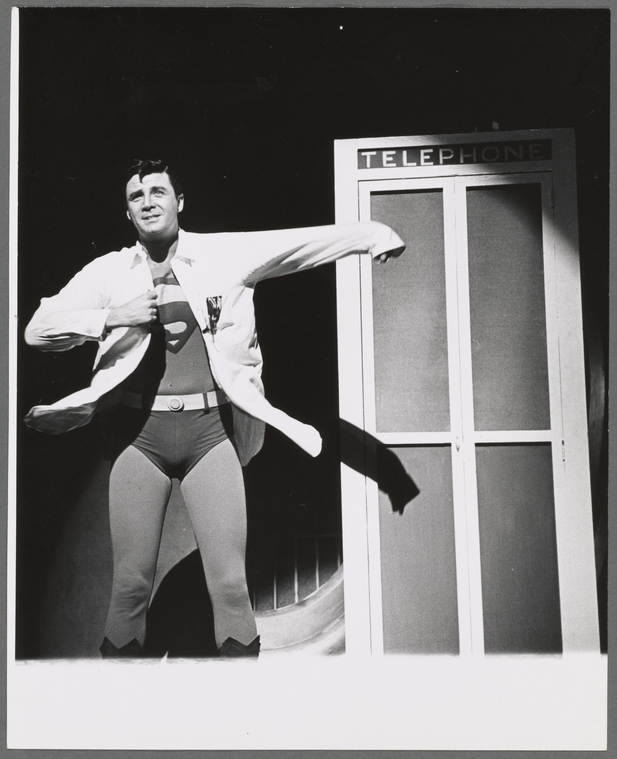
by Aaron Grunfeld
[Every so often, one of our readers submits a guest article. We're always delighted to receive such unexpected bounty, and this one is particularly fun and relevant.
Aaron Grunfeld is a former journalist and dramaturg. In the past he has worked with playwrights and theaters on and Off-Broadway, and written for publications like Playbill. Aaron lives in New York City with his wife and daughter, and he’s preparing to teach high school English this fall.
As a science-fiction fan, Aaron is enjoying Adventure Comics, where Edmond Hamilton is currently writing a light-hearted space opera starring Superboy and a team of teen super-pals in the 30th century. Highly recommended!]

Batman may be the biggest superhero of 1966, but his pal Superman can still draw a crowd. This past spring, the Man of Steel was featured in a brand-new Broadway musical with a tongue-in-cheek title: It’s a Bird… It’s a Plane… It’s Superman! But a marriage between the Great White Way and the Funny Pages isn’t as strange as it sounds. Television, comic books, and American musicals are all forms of ‘pop art,’ the trendy term for work that’s meant to be popular, mass-produced, and ephemeral. That definition clearly applied to Superman’s show, which only ran for four months. It was a flop by most measures, but not the one that counts: the producers recouped their costs.
Onstage at the Alvin Theatre, Superman faces a mad scientist who’s teamed with a gossip columnist at the Daily Planet; together they hope to ruin the superhero’s reputation. The newsroom is also the setting for the comic’s legendary love triangle, with reporter Lois Lane at its apex and Superman as his own rival. This angle is played as romantic comedy, and as a result, Superman feels less like a comic-book adventure than a generic musical with a superheroic twist. All the action takes place in Metropolis, which is identical to Broadway’s vision of New York—a cynical, seen-it-all borough that breaks into song & dance every so often. Superman floats gently into the chorus of hoofers like he’s gliding off the movie screen at a Saturday matinee. He’s just as earnest and good-natured as he ever was, and his fellow citizens can’t take him seriously in the red cape and blue tights. Neither can the show’s creators, Charles Strouse and Lee Adams, who had a hit a few years ago with Bye Bye Birdie. Strouse and Adams have developed Superman with book writers David Newman and Robert Benton and director Harold Prince (Jerry Siegel and Joe Shuster originated the concept in 1938). Their Superman is a galoot with a big heart, and their impulse is to mock him. His super-feats are played for knowing laughs; when Superman swoops in on wires, he strikes a pose like Mary Martin in Peter Pan. I’m not sure why Strouse and Adams wrote a musical about Superman, rather than, say, Li’l Orphan Annie. I’m not sure they know either. The actors are uniformly better than their material, and many received acclaim for their efforts. Bob Holiday plays the dual role of Clark Kent and Superman as so essentially decent that the show’s mockery just bounces off him. In the second act, he laments, “Why can’t the strongest man in the world | Be the happiest man in the world?” and for a moment, it seems like he’ll reveal his secret identity to Lois. Wouldn’t that be a twist! Those who remember Lois Lane from the radio, or those incredible cartoon shorts during the war, will be disappointed that the musical’s newshound is more focused on wedlock than journalism. It’s a retrograde portrayal that feels out-of-step with the current decade; I’d like to think Lois is still reporting on civic corruption and civil unrest, not that she’s writing the Daily Planet’s advice column. However, the audience enjoyed her romantic antics, as executed by Patricia Marand, and, if her Tony nomination is anything to go by, so did her peers. I found the show’s two villains more lively. Michael O’Sullivan plays a generic mad scientist, a “ten-time Nobel loser” who blames Superman for his failures. A veteran of vaudeville, O’Sullivan mugs and hams his way through the show like a cut-rate Bert Lahr. He’s at his best opposite Jack Cassidy, who plays a Walter Winchell type and goes for every laugh he can find. They’re a pair of old-fashioned entertainers who give the audience what we paid for: Broadway schtick done slick. For that, both men also earned Tony nominations. None of the show’s performers won their categories, but all three are professionals enjoying their work, and in the theater, that feeling is infectious. The spotlight, however, is stolen by an up-and-comer named Linda Lavin. She plays a secretary who flirts with Clark Kent in a number called “You’ve Got Possibilities.” The lyrics suggest she views the mild-mannered reporter as a fixer-upper, a groom to be groomed. But in performance, Lavin’s character finds Kent genuinely, carnally attractive, and she’s not afraid to say so. “Possibilities” is the show’s strongest number, and Lavin uses it to make a big impression. All the critics agreed, Lavin is Superman’s high point. I’ll go further: Lavin is the only modern, original part of the entire Superman musical. In its cultural attitudes, Superman is a throwback to the era between the War and Kennedy’s assassination. This is clearest in its treatment of Lois Lane, but it permeates the show. Lavin’s character, by contrast, doesn’t want to marry Superman, or even Clark Kent. She enjoys her independence, and she’s too busy living her own life to bother with the heroic melodrama of Superman. Lavin’s creation is looking forward, not back, and her moments onstage elevate the Superman musical from light entertainment to pop art. Two and a half stars.









![[August 4, 1966] Up, up, and away! (the <i>Superman</i> musical)](https://galacticjourney.org/wp-content/uploads/2021/08/660804b-672x372.jpg)
